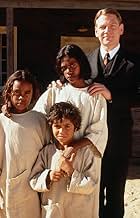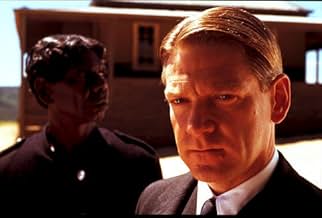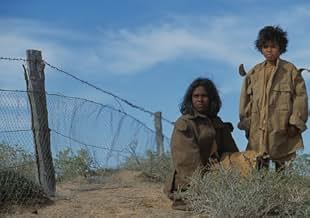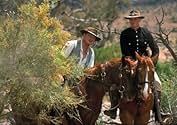Im Jahr 1931 fliehen drei halb weiße Mädchen, halb Aborigines, nachdem sie aus ihren Häusern genommen wurden, um als Hausangestellte ausgebildet zu werden, und machen sich auf den Weg über d... Alles lesenIm Jahr 1931 fliehen drei halb weiße Mädchen, halb Aborigines, nachdem sie aus ihren Häusern genommen wurden, um als Hausangestellte ausgebildet zu werden, und machen sich auf den Weg über das Outback.Im Jahr 1931 fliehen drei halb weiße Mädchen, halb Aborigines, nachdem sie aus ihren Häusern genommen wurden, um als Hausangestellte ausgebildet zu werden, und machen sich auf den Weg über das Outback.
- Regie
- Drehbuch
- Hauptbesetzung
- Auszeichnungen
- 23 Gewinne & 25 Nominierungen insgesamt
- Miss Thomas
- (as Lorna Leslie)
Empfohlene Bewertungen
I managed to fluke free preview tickets for this because the tickets I had come to collect were all gone! I must admit this film hadn't really appealed to me when I saw summaries and the poster, but I'm very glad that I did. The plot is based on fact and is a period of history that I admit I knew nothing about. I was surprised that this cruel and immoral practice carried on till as late as the seventies. The fact that the current Prime Minister of Australia refuses to apologise for it to this day shows that it is important that this story be told.
The film is told in a steady, unsentimental tone that allows the film to be powerful without the typically Hollywood use of sweeping music or other such lazy tools. Instead the circumstances of the story create the emotion. The story is a little weak at some points once the children escape the film has a touch too many scenes of near-capture and escape to sustain the drama. Also the film (understandably) lends a lot of respect to the Aborigines giving them a sense of mysticism that they maybe don't deserve. This is a slight problem when a key action involves a hawk that is supposedly summoned by their mothers (or something!). However these are minor complaints given the sweeping emotion of the film and the sheer power of the story.
The production and direction are excellent. Noyce has created a beautiful vision of the Australian Outback that really feeds the film. However the sound is also superb. Rhythmic footsteps ring out, crunching and banging of the landscape it works best in a cinema I guess but it adds to the dramatic feel of the film, even if some sudden noises caused me to jump without any reason in the scene to do so.
The cast are mixed but are important where it matters. Sampi is amazing as Molly. She carries the film with her strength but also little facial expressions that reveal that she is a child, reveal her strength and tell so very much. Both Sansbury and Monaghan also do well but not as well as the lead. Branagh is also perfectly pitched. Neville could easily have been overplayed as a hammy villain of the piece but here he is played just right he is a real man and we are left to decide for ourselves what to make of him. Some of the cast are average some of the children in the camp can't act and the majority of the white police officers are maybe a shade too much caricatured as evil men who dislike the blacks.
Overall this film may struggle to draw the Friday night crowd just looking for a bit of escapism of a weekend, but it is still well worth a look. It is beautifully shot and uses the Australian landscape to great effect complimenting the enormity and emotion of the terrible, terrible true story. Not exactly cheerful or uplifting but a powerful story that deserves 90 minutes of your time.
As for all journeys, they are filled with internal conflict and confrontations with strangers. These confrontations with certain people show the diverse group of settlers in Australia. Not all were ignorant but most were repressed and abided to the harsh cultured laws. For instance, the girls arrive at a farmstead and are given clothing and food by a white woman. The motherly instinct of this woman understood that the girls had to be with their mothers. But at the same token the farm woman could not jeopardise her own family by looking after the girls or else it would have brought trouble. It was wonderful scenes like these that was played out visually without having to dumb it down with words. As human beings we understand these actions and need no explaining.
The most interesting relationship was the one between the aboriginal tracker in search of the girls. He could sense the persistence of these girls to get home by making it difficult for him to track them down. This he respected and slightly dropped his guard. Once again, a string of images tell of this distant relationship between tracker and girls.
The images also became so strong during the scene when the girls were taken from their mothers in a horrific manner. I doubt there will be a dry eye during that scene. This hooks you in as you then become the spirit of their journey back home.
Only by the performances of the girls do these scenes work because they are so natural and heartfelt. Children who overplay their role just become cute but those who underplay and rely on emotions of the situation deliver a powerhouse performance that a trained actor may sometimes find difficult to achieve. At first the name of a high calibre actor - such as Kenneth Branagh - in an Australian film warns you where the limelight will shine. But Kenneth just took a step back and become another important confrontational figure in the journey.
A bonus is the music by Peter Gabriel. It is a mixture of his famous trademark of world music infused with that of the Aboriginal. It soars and plays with the emotions, maybe a little too much but when you are dealing with a thousand year old culture that has music as its central universe, then you may be able to understand that the overpowerful music is just an extension of that.
Congratulations to all who were brave enough to bring a project of this strength to the screen. And for those who may wonder how I saw the film prior to its release, lets just say I was lucky enough to be at the right place at the right time. And No! I'm not tied to the project in any way because I don't sell out that easily.
Set in Western Australia in 1931, Rabbit-Proof Fence, a new film by Australian director Philip Noyce (The Quiet American, Clear and Present Danger), is a scathing attack on the Australian government's "eugenics" policy toward Aboriginal half-castes. Continuing policies begun by the British, the white government in Australia for six decades forcibly removed all half-caste Aborigines from their families "for their own good" and sent them to government camps where they were raised as servants, converted to Christianity, and eventually assimilated into white society.
Based on the 1996 book, "Follow the Rabbit-Proof Fence" by Doris Pilkington Garimara (Molly Kelly's daughter), the film tells the story of three Aboriginal girls, 14-year old Molly Kelley, her 8-year old sister Daisy, and their 10-year old cousin Gracie. It shows their escape from confinement in a government camp for half-castes and their return home across the vast and lonely Australian Outback. It is a simple story of indomitable courage, told with honest emotion. Abducted by police in 1931 from their families at Jigalong, an Aboriginal settlement on the edge of the Little Sandy Desert in northwest Australia, the three girls are sent to the Moore River Native Settlement near Perth. Here the children must endure wretched conditions. Herded into mass dormitories, they are not allowed to speak their native language, are subject to strict discipline, and, if they break the rules, are put into solitary confinement for 14 days.
Followed by the Aborigine tracker, Moodoo (a great performance from David Gulpilil), the girls make their escape. Using a "rabbit-proof fence" as a navigation tool, they walk 1500 miles across the parched Outback to return to Jigalong. The rabbit-proof fence was a strip of barbed-wire netting that cut across half of the continent and was designed to protect farmer's crops by keeping the rabbits away. The girls walked for months on end often without food or drink, not always sure of the direction they are going, using all their ingenuity and intelligence along the way just to survive. The stunning Australian landscape is magnificently photographed by Christopher Doyle, and a haunting score by Peter Gabriel translates natural sounds of birds, animals, wind and rain into music that adds a mystical feeling to the journey.
The performances by amateur actors Evelyn Sampi, Tianna Sansbury, and Laura Monaghan (who had never seen a film before let alone acted in one) are authentic and heartbreakingly affecting. Though the white officials and police are characterized as smug and unfeeling, they are more like bureaucrats carrying out official policies than true villains. Kenneth Branagh gives a strong but restrained performance as Mr. Neville, the minister in charge of half-castes. Rabbit-Proof Fence is an honest film that avoids sentimentality and lets the courage and natural wisdom of the girls shine through. This is one of the best films I've seen this year and has struck a responsive chord in Australia and all over the world. Hopefully, it will become a vehicle for reconciliation, so that the shame of the "Stolen Generation" can at last be held to account.
For those who do not know the desert regions of Australia, it must be said that the "outback" country is harsh and cruel and can only be crossed by those with experience...those with a knowledge of the land. I think the camera makes it clear that the hostile environment is very much like a fence in itself...almost impossible to cross. All the more remarkable therefore that these girls accomplished what they set out to do. May be it was a reckless decision they made but thanks to the fence they found their way back to family and friends.
The film is largely a record of the long trek and the manner in which the children are able to survive. There are not many dramatic moments on their journey south. The children are mainly concerned with avoiding the blacktracker who is following them. The most unforgettable scene comes early in the film when the children are forcibly torn from their mothers. This is truly heart-wrenching stuff.
This thoughtful presentation is worth watching. It is part of Australian history.
Wusstest du schon
- WissenswertesEverlyn Sampi (Molly Craig) ran away twice during filming. In one instance, she was found in a phone booth, trying to buy tickets back to Broome.
- PatzerThe three girls Molly, Gracie and Daisy were not taken by surprise and removed by force from Jigalong. The violent removal scene in the film is entirely fictional. The girls' mothers were informed beforehand they were to travel with Constable Riggs and, without any protest, they acquiesced in the decision. The girls left Jigalong on horseback, not locked in a motor car.
- Zitate
Daisy Kadibill: [after Molly lifts Daisy up to a bird's nest to gather some eggs to eat] Three of them!
Molly Craig: Perfect. One for you, one for me, and one for both of us!
- Crazy CreditsThe painting songs sung by the Walpiri, Amatjere and Wangajunka women were not sacred songs, but were songs able to be performed in public.
- VerbindungenEdited from A Steam Train Passes (1974)
- SoundtracksNgankarrparni
(Sky Blue Reprise) (2002)
Written by Peter Gabriel
Featured by The Blind Boys of Alabama, Myarn Lawford (as Myarn) and Ningali Lawford
Top-Auswahl
- How long is Rabbit-Proof Fence?Powered by Alexa
Details
- Erscheinungsdatum
- Herkunftsland
- Offizieller Standort
- Sprachen
- Auch bekannt als
- Rabbit-Proof Fence
- Drehorte
- Produktionsfirmen
- Weitere beteiligte Unternehmen bei IMDbPro anzeigen
Box Office
- Budget
- 6.000.000 $ (geschätzt)
- Bruttoertrag in den USA und Kanada
- 6.199.600 $
- Eröffnungswochenende in den USA und in Kanada
- 88.352 $
- 1. Dez. 2002
- Weltweiter Bruttoertrag
- 16.220.968 $
- Laufzeit
- 1 Std. 34 Min.(94 min)
- Farbe
- Sound-Mix
- Seitenverhältnis
- 2.35 : 1



















